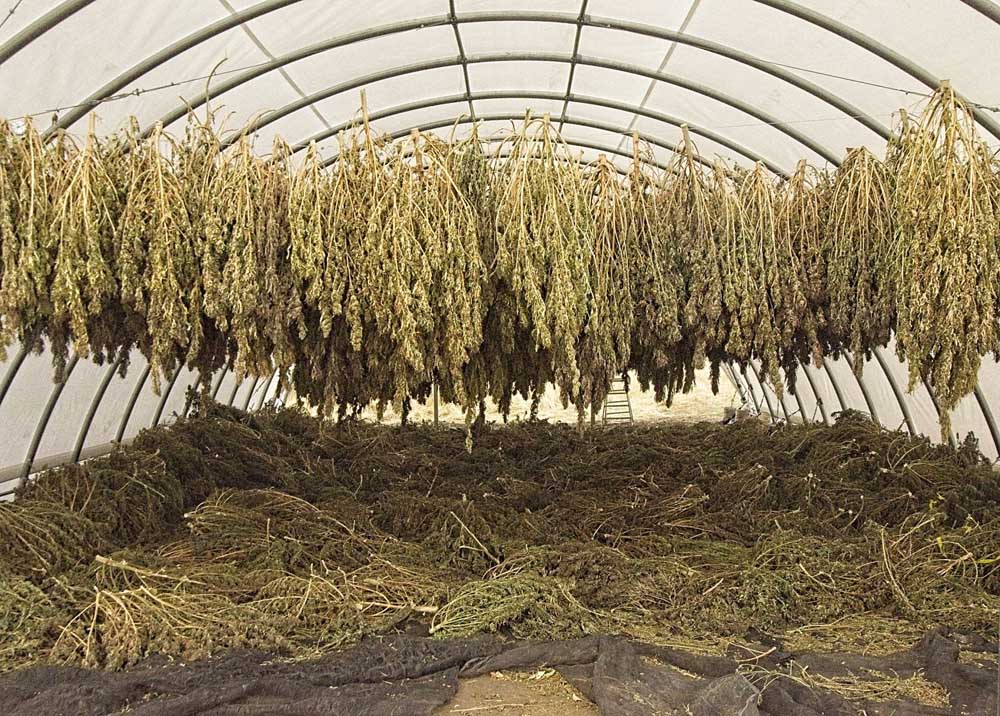Hemp prices ‘race to the bottom,’ souring grower enthusiasm
Published 1:45 pm Friday, April 30, 2021

- Hemp plants dry on a farm east of Joseph in this 2019 photo.
Stockpiles of unsold hemp are weighing down prices for the crop and souring enthusiasm among farmers who’d until recently hoped for a lucrative new market. In a dynamic that’s not uncommon in agriculture, hemp production has overshot demand, which was once thought to be expansive, said Barry Cook, a hemp seed grower in Boring
. “The consumer component of it was assumed, a bit like the Field of Dreams: Grow it and you will sell it,” he said. That assumption turned out to be overly optimistic, as some growers are still sitting on dried hemp inventory from 2019, when the fervor to plant the crop was at its highest, Cook said. Farmers are now being offered $1 per pound or less for dry hemp biomass, which is roughly half as much as it costs to produce it, even among the most efficient growers, he said.
In Oregon, a frontrunner in the hemp industry, acreage soared after the crop was legalized at the national level in 2018. Growers planted nearly 64,000 acres in 2019, up from 11,500 acres the year before. The economic problems facing hemp production became widely apparent that autumn, when many farmers weren’t able to access enough harvesting and processing equipment. Oregon’s production in 2020 dropped to 28,500 acres and appears to be further declining in 2021, with only 3,800 acres currently registered for planting — down roughly 50% from this time last year, according to the Oregon Department of Agriculture. “There’s a lot of biomass still out there, and growers aren’t getting paid for it,” said Ken Iverson, a hemp farmer and processor in Woodburn
.
The hemp industry overestimated the appetite for cannabidiol, or CBD, a compound considered to have anti-inflammatory and other healthful properties, Iverson said. Nationwide, farmers planted more than 500,000 acres of hemp while only about 20,000 acres were sufficient to satisfy the CBD market, he said. “It’s still way out of balance.” A survey of hemp farmers by Whitney Economics in 2019 found that 65% didn’t have a buyer for their crop, while a similar survey in 2020 determined 54% of processors also did not, said Beau Whitney, an economist who founded the firm and studies the industry. When processors lacked the funds to extract CBD oil, they began charging farmers for the service rather than convincing product manufacturers to invest more money, he said. “It’s sort of an upside-down business model.” Oregon and other states that jumped into hemp early have pulled back on acreage, but that didn’t cause a major national contraction in 2020 because other states ramped up their production, Whitney said. Though the nationwide hemp industry is likely to decrease acreage in 2021, some distressed farmers and processors are trying to salvage their investment by selling below the cost of production — resulting in a “race to the bottom” in prices, he said. “That’s scaring away people,” Whitney said. There’s been a “domino effect” of plummeting demand through the hemp supply chain, all the way to seed production, said Jerry Norton, an industry consultant in Salem
.
Despite the economic turmoil, Norton said he’s hopeful that other uses for hemp — such as livestock feed and biodegradable plastic — will firm up the crop’s market over time. “There are a lot of other things we can do,” he said. By 2030, demand for such hemp products may spur the crop to 9 million acres at the national level, with only 3% dedicated to CBD production, said Whitney, the economist. Currently, about 82% of the 500,000 hemp acres in the U.S. are intended for CBD. The demand for CBD will strengthen if the U.S. Food and Drug Administration decides to allow the compound to be marketed as a dietary supplement, rather than strictly a pharmaceutical, said Seth Crawford, a hemp seed breeder near Monmouth. Unless that happens, the industry will continue operating in a gray area that discourages investment, he said. “It’s not good for farmers, it’s not good for product manufacturers, and quite frankly, it’s not good for consumers.” In the meantime, growers are suffering and processors are going out of business, Crawford said. “I’m just hoping there’s an industry left when the ruling is made.” If hemp products cross the threshold of 0.3% THC — the intoxicating compound in marijuana — they become illegal federally, which has complicated enforcement by the FDA and U.S. Drug Enforcement Administration, said Whitney, the economist. Hesitancy at the federal level has filtered through to state regulators, whose strict controls are “suffocating the market,” he said, adding that major manufacturers, such as Coca-Cola, aren’t prepared to invest in an industry facing such a precarious outlook. “The real big money’s sitting on the sidelines, waiting for the regulatory uncertainty to clear up,” Whitney said. “A lot of this would be cleared up by clearing up the regulatory uncertainty at the federal level.”






